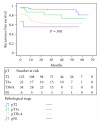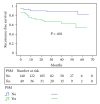Oncologic outcomes of asian men with clinically localized prostate cancer after extraperitoneal laparoscopic radical prostatectomy: a single-institution experience
- PMID: 22110998
- PMCID: PMC3216056
- DOI: 10.1155/2011/748616
Oncologic outcomes of asian men with clinically localized prostate cancer after extraperitoneal laparoscopic radical prostatectomy: a single-institution experience
Abstract
Purpose. To evaluate the midterm oncologic results of extraperitoneal laparoscopic radical prostatectomy (EPLRP) for Asian men with localized prostate cancer. Methods. Between 2004 and 2009, 218 men underwent EPLRP at an Asian tertiary hospital. The mean preoperative prostate-specific antigen (PSA) was 15.5 ng/ml and mean Gleason score was 6.6. Stage distributions were cT1a-b in 21 cases, cT1c in 139, cT2 in 48 and cT3 in 10. Disease recurrence was defined as PSA ≥ 0.2 ng/mL in 2 consecutive measurements or initiation of secondary therapy. Results. Postoperative pathological stage was pT2a-b in 33 patients, pT2cN0 in 10, pT3a in 27, pT3b in 36, pT4 in 9 and pN1 in 10. Positive surgical margins occurred in 14.6% and 48.6% for pT2 and pT3 diseases, respectively (P < .001). The overall PSA recurrence-free survival at 3 and 5 years was 82.1% and 74.5%. By the pathological stages, 3-year recurrence-free survival was 92.4% (pT2), 81.1% (pT3a), 62.6% (pT3b-4) and 55.6% (pN1), respectively (P < .001). Conclusions. EPLRP is curative even for some locally advanced prostate cancers in a midterm follow-up. Even at an Asian center of low volume of radical prostatectomy EPLRP still provides oncologic outcomes similar to that of high volume centers.
Figures






Similar articles
-
Oncologic outcome after extraperitoneal laparoscopic radical prostatectomy: midterm follow-up of 1115 procedures.Eur Urol. 2010 Feb;57(2):267-72. doi: 10.1016/j.eururo.2009.09.029. Epub 2009 Sep 17. Eur Urol. 2010. PMID: 19775807
-
Impact of positive surgical margins on prostate-specific antigen failure after radical prostatectomy in adjuvant treatment-naïve patients.BJU Int. 2011 Jun;107(11):1748-54. doi: 10.1111/j.1464-410X.2010.09728.x. Epub 2010 Sep 30. BJU Int. 2011. PMID: 20883488
-
Evaluating the oncologic outcomes in 152 patients undergoing extraperitoneal laparoscopic radical prostatectomy.Chin Med J (Engl). 2012 May;125(9):1529-35. Chin Med J (Engl). 2012. PMID: 22800816
-
Laparoscopic radical prostatectomy: oncological evaluation after 1,000 cases a Montsouris Institute.J Urol. 2003 Apr;169(4):1261-6. doi: 10.1097/01.ju.0000055141.36916.be. J Urol. 2003. PMID: 12629339
-
Long-term oncological outcomes after laparoscopic radical prostatectomy.BJU Int. 2013 Feb;111(2):271-80. doi: 10.1111/j.1464-410X.2012.11317.x. Epub 2012 Jul 3. BJU Int. 2013. PMID: 22757970 Review.
References
-
- Taiwan Cancer Registry: Annual Reports of Taiwan Cancer Registry. http://tcr.cph.ntu.edu.tw/uploadimages/Year_Male%20genital.xls.
-
- Richie JP. Localized prostate cancer: overview of surgical management. Urology. 1997;49(3):35–37. - PubMed
-
- Korman HJ, Leu PB, Huang RR, Goldstein NS. A centralized comparison of radical perineal and retropubic prostatectomy specimens: is there a difference according to the surgical approach? Journal of Urology. 2002;168(3):991–994. - PubMed
-
- Walsh PC, Lepor H, Eggleston JC. Radical prostatectomy with preservation of sexual function: anatomical and pathological considerations. Prostate. 1983;4(5):473–485. - PubMed
-
- Eggleston JC, Walsh PC. Radical prostatectomy with preservation of sexual function: pathological findings in the first 100 cases. Journal of Urology. 1985;134(6):1146–1148. - PubMed
LinkOut - more resources
Full Text Sources
Research Materials
Miscellaneous

